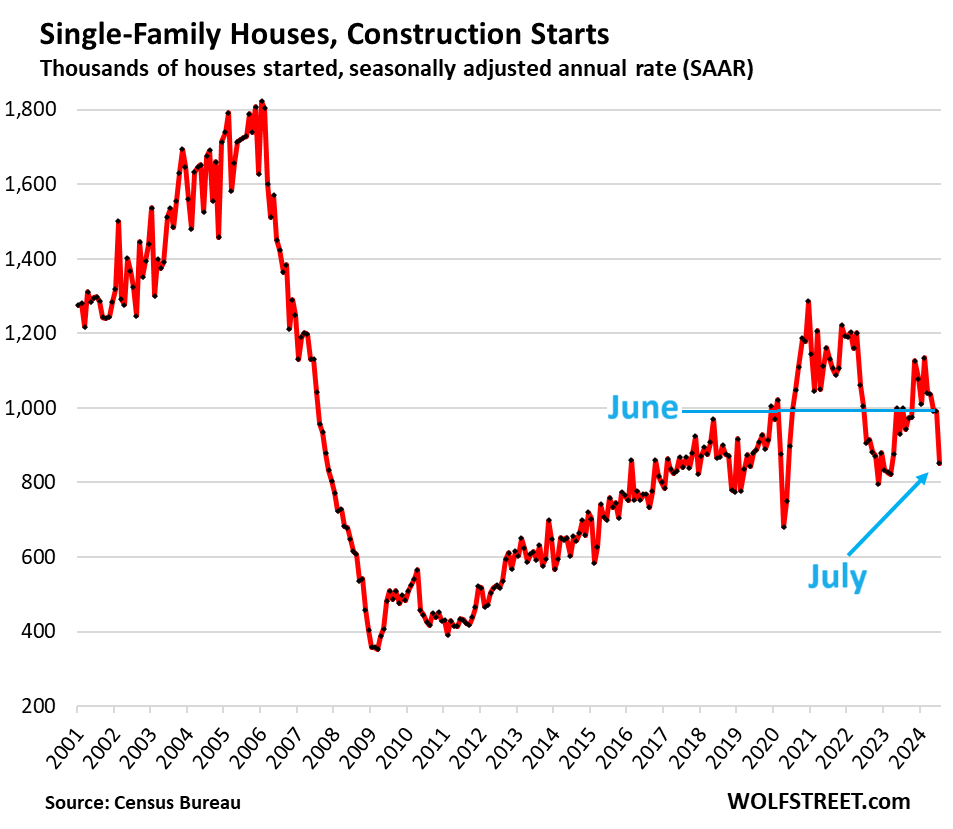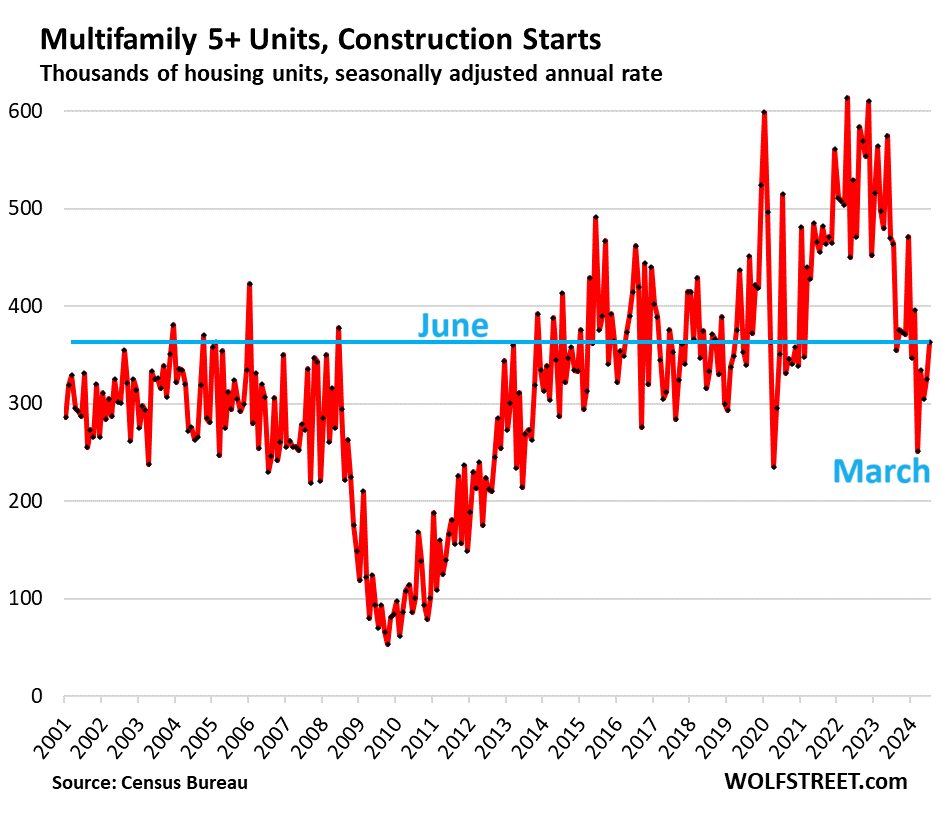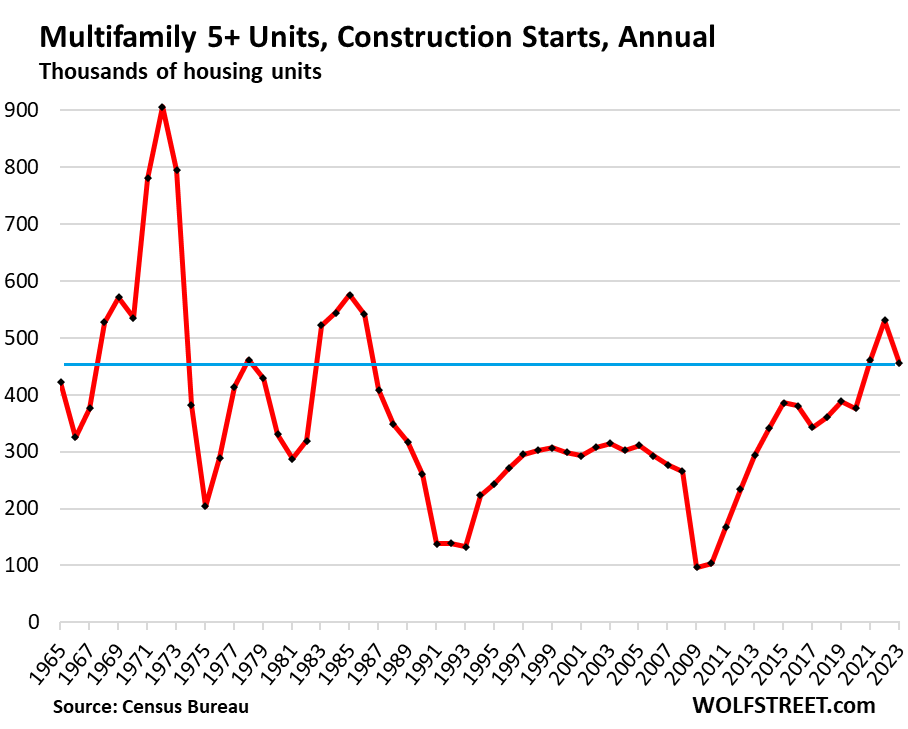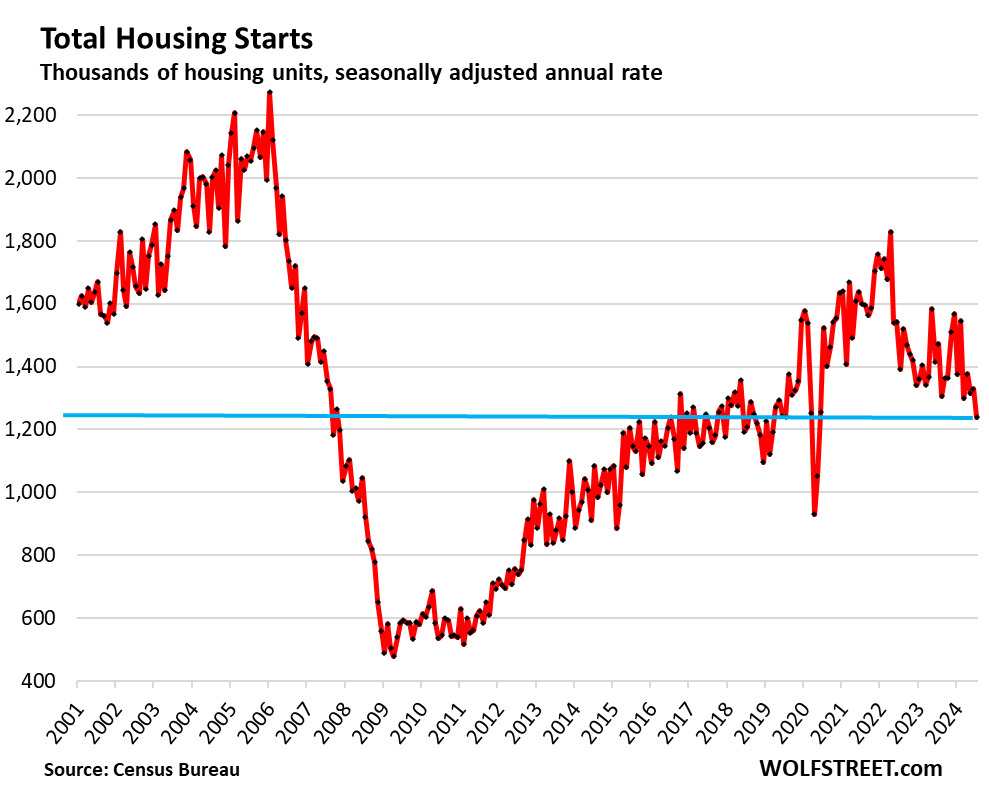What we’re worried about and what we’re not worried about.
By Wolf Richter for WOLF STREET.
The headlines about residential construction starts this morning were of the-end-is-nigh type: “New-home construction plunges to lowest level since May 2020.” They were triggered by the data from the Census Bureau on construction starts of housing units in July: they dropped 6.8% from June, to a seasonally adjusted annual rate of 1.238 million single-family houses and units in multifamily buildings, the slowest pace since May 2020.
The drop was driven by single-family housing starts that suddenly plunged 14% in July, the biggest month-to-month plunge since lockdown-April 2020, though they’d done pretty well through June. That 14% plunge from June was a huge outlier move. June had been up 6% year-over-year and was well above the pre-pandemic pace, though it was slower than the frenetic pace of 2021 and 2022. Long-term construction planning doesn’t change on a dime like that.

The outlier-move in single-family starts coincided with Hurricane Beryl sweeping across the Gulf Coast in early July, which has shown up in other data, including a sudden spike in initial unemployment claims that had caused some wailing and gnashing of teeth in the rate-cut circus, but that then fell off again, and yesterday dropped to the lowest level in over a month, and were about 10% below a year ago.
So the construction industry in the South was dealing with the bad-weather effects of Hurricane Beryl. And that portion of the plunge in construction starts will bounce back.
But multifamily construction jumped 11.7% in July from June, the second monthly jump in a row, and were up 45% from the March low — though commercial real estate, including multifamily, is in a depression with loans defaulting left and right, and properties selling at huge discounts including at foreclosure sales, which we’ve been wringing our hands over for two years.
With lenders losing oodles of money on their loans, lending has gotten so tight that it became like a noose around the neck of developers. In addition, big projects that take years to plan and get approved were conceived in an era of 3% mortgages, and they may not make economic sense with mortgages at 7%, and lenders don’t want to fund a project that is economically doomed to fail and saddle them with losses. Many multifamily projects are stalled because they cannot get funding.
And yet construction starts jumped for the second month in a row, from the beaten-down pace of the prior months – a sign that they might have bottomed out in the spring.
In March, multifamily construction starts had plunged by 37% from the prior month, and by nearly 50% year-over-year to a seasonally adjusted annual rate of 251,000 units. And that may have been the bottom.
Since March, multifamily construction starts have jumped by 45%, to 363,000 units in July, which was still down 22% year-over-year, but off the bottom – back in the middle of the prepandemic range, and higher than in the years before 2013:

Multifamily had gone through a phenomenal construction boom. In the year 2021, over 473,800 housing units were started, the most since the fading construction boom in 1987. In 2022, multifamily starts jumped to 547,400, the most since 1986. In 2023, 468,600 units were started, with the first half still being strong, but then the CRE depression started invading in the second half. These were huge numbers. And those buildings – condos and rental apartments – are now coming on the market, amid fears of substantial oversupply in some markets (which would be a good thing for renters and condo buyers, but not for developers, landlords, and lenders).
Here is the long view, going back to 1965, of the dramatic multifamily construction booms back in the 1970s and 1980s, and how the boom in 2021-2023 stacked up:

So overall residential construction starts dropped by 6.8% in July from June, to a seasonally adjusted annual rate of 1.238 million, which was down 16% from a year ago, driven by the outlier drop in single-family starts:

What we’re worried about and what we’re not worried about.
We know that residential construction has cooled from the frenetic pace of 2021 and 2022.
Multifamily went through a construction surge that took it to multidecade highs, triggering fears of massive overbuilding as these units are now coming on the market. Nearly all new multifamily projects – condos or rental apartments – are at the higher end because that’s where the money is.
CRE has been in a depression for well over a year, and a year ago, multifamily construction starts showed the beginnings of a massive drop from the frenetic pace in the prior years. And that drop from the boom levels is substantial and has been felt for a year, and will be felt, and it worries us, but it may have bottomed out this spring, by the looks of it.
But the outlier-move in single-family construction in July, triggered by something other than long-term planning, is not on our worry list. Single-family construction has cooled from the frenetic pace in 2021 and 2022. But year-to-date through June, it was decent and well above the prepandemic years, and that’s likely the trend going forward.
Enjoy reading WOLF STREET and want to support it? You can donate. I appreciate it immensely. Click on the mug to find out how:
![]()


1:04 PM 8/16/2024
Dow 40,659.76 96.70 0.24%
S&P 500 5,554.25 11.03 0.20%
Nasdaq 17,631.72 37.22 0.21%
VIX 14.75 -0.48 -3.15%
Gold 2,547.80 55.40 2.22%
Oil 76.75 -1.41 -1.80%
Florida is a sh*t show in general. MF has overbuilt class A, massive hurricanes, and massive insurance costs. Plus can’t refi. because of high interest rates.
Mortgage interest rates are near historically low levels.
Don’t be pedantic. Mortgage interest rates are currently higher than the rates on most people’s existing mortgages; therefore, refinancing doesn’t make any sense for most people.
So what?
So people can’t refinance. RTGDFC.
So, what was THE specific reason for the single family construction “outlier” in July? Beryl hit the Southwest etc. but what about the data from the other regions that were not affected?
1. The South is a big place with lots of growth in single-family construction.
2. The data cited here are “seasonally adjusted annual rates.” So the number of starts would be during an entire year at the July pace. This number looks big because it’s an annual rate.
3. In actual starts, not seasonally adjusted, single-family starts dropped by 14,600 units in July from June. When you think about how vast of a region is impacted by the bad weather that comes with a major hurricane when construction starts are put on hold, a drop of 14,600 houses is not such a big number.
4. there are always a lot of monthly squiggles as you can see in the chart. So some of the July drop is also part of the month-to-month squiggles, as always.
The seasonally adjusted annual rate would do it. Thanks
Here in the Midwest we had pretty heavy rainfall in the spring and summer. This is anecdotal, but a lot of builders weren’t able to excavate dirt to pour a foundation because the soil was water logged until about June, depending on the area. Without your footers, the other 95% of the build can’t take place. I’m not sure how much that affects the data, just thought I’d share my observations from MN.
Patch: Home Values In 2 SoCal Cities Top $1 Trillion As Prices Surge
One SoCal city recently joined the trillion-dollar club, and another will likely join the club within a year.
Southern California now includes to two metros in the trillion-dollar club, after Anaheim’s aggregate home value reached more than $1 trillion, according to Redfin.
Values in Anaheim increased by almost $121.04 billion in the past 12 months, for an aggregate of nearly $1.12 trillion, according to the real estate website, which noted the area had the third-highest gains in the country at 12.1 percent.
In passing the trillion-dollar mark, Anaheim joins Los Angeles, which has an aggregate value of almost $2.19 trillion and is up nearly $127.98 billion year-over-year, according to Redfin.
What a great time to be alive! Homeowners just can’t stop winning, it’s like that money printer that just won’t stop
Well unless you’re a non-homeowner, then get out of the way peasants….the window of opportunity was missed and will never come again.
There’s a lot of places in this country where housing prices are not increasing at a rate like in Ca and other prime states.
But are still out of reach for those who work and live in them
If you missed the boat and are feeling down, no house, lost job, sitting on the curb with your head in you hand, say a small prayer to the most gracious house God.
Then like a miracle you see off to your left, in a well trimmed yard a small house with your name written in bold letters across the top, in says….charlie.🐾
PI, go replace your oil burner, roof, and siding. Get your septic system updated to current specifications. Have your well-water speced. And watch your School Taxes go up every years for a declining enrollment. And then get this with ‘Capital Gains’ tax when you try to leave the place.
“Well unless you’re a non-homeowner”
Or a homeowner with no plans to sell. Then you just get higher property tax & insurance, and zero benefits of the theoretical resale value of the home.
You do get equity to borrow against. That could be quite valuable, applied to the correct opportunity.
Mortgage rates aren’t coming down as fast or as hard as bond yields. The Wall St housing industry has access to lower credit rates, and they can make money on that spread. Consumer confidence is strong. The labor market is accommodative to labor. Seems like the perfect cocktail for higher home prices. The supply of available housing near jobs and in areas with desirable climate, healthcare and local and state government services is limited. Large parts of America are unlivable. Housing with the 3 L’s and particularly existing housing should continue to create even more magnificent bubbles.
Depending on who you believe, the US is short between 1.5 and 3.5 million sf homes. At these construction rates, we’re going to stay undersupplied and prices are going to continue to move higher.
As mortgage rates move lower, I believe there will be more buyers, who have been sitting on the sidelines that will start buying, than sellers who will want to trade out of their current properties and face higher mortgage rates and much higher real estate taxes, not to mention the cost of moving.
CCCB,
You’re citing RE promo bullshit.
There is a glut of apartments/condos in lots of markets, and inventories of vacant houses for sale have been rising. Where do they come from? The homes have been vacant but were kept off the market for speculative reasons. Watch them come out of the woodwork.
The only shortage there is is affordable homes. A big price drop would make homes more affordable. But everyone wants to buy an affordable home, no one wants to own or sell one. That means once people have a home, they want prices to go up and become unaffordable, and the RE promo bullshit you and others cite is in part to blame.
Beryl left a huge swath of devastation across the entire eastern US. Northern VT experienced an 8.24 inch deluge from the remnants of Beryl in July on exactly the first anniversary of a devastating deluge that had wiped out entire communities. It’s not just beachfront property at risk. Housing that stood for over a century now obliterated merely adds to the climate change housing crises constantly accelerating.
Addendum: “Drill Baby, Drill!!!”
Thanks for your “aware” post.
The crazy thing about multi-family construction is the disconnect between supply and demand. Developers keep piling on more and more apartments in some of the most saturated markets in the country (mostly in the sunbelt) while ignoring many markets, even large ones, with low vacancy rates. The allocation of capital in commercial real estate is really messed up.
Don’t remember 100 years ago, or know about all of FL, but the year round population of Collier county was 15,000 in the 1960 census, and that’s for 2,300 Square Miles, ( including all the swamps, etc. )
Can’t even guess that number these days, eh?
OK, just checked, and the current census bureau estimate is right at 400,000.
Truly amazing what happens to a state owned lock stock and barrel by developers, eh?
Developers? More like before ac…after ac…
Dad chased the mini ice age to find cooler digs.
Now his grand kids are chasing Al’s global warming.
What made Florida habitable was air conditioning. Before that existed not many people wanted to live there year-round. Try it some summer and see.
I was there in 1965 – 66 at Orlando AFB (training) before I went overseas. Our barracks didn’t have A/C. matter of fact, nothing did. I swore I would never go back there.
Exactly CORRECT cat,,,
Was there from 1944 to 1964 without central air, though we did have some wall bangers the last couple years..
One can ”get used to it” when young and healthy; not so much when older, of which I am very aware the last decade after returning to care for elderly in laws who had lived here 90+ years with no AC and had got used to it somehow.
OTOH, about 65% of the population leaving at end of March and another 15% or more by end of April made FL back in the day a veritable kid’s paradise, with empty houses and especially empty swimming pools readily available, and the fishing and crabbing like TOTALLY abundant.
Next week, the new NAR rules go into effect cutting the payment by buyers to realtors to 3% for the selling agent only and making the buyer responsible for paying a 3% or lower or high fee to their buying agent should they want to even have a buying agent. This is expected to cause some turmoil in the residential real estate industry.
I am sure it will be a nothing burger and homes in SoCal will still be snatch up at like nothing happened
Howdy SoCal. Buyers will be up against the Seller and their agent. That s why the NAR is representing sellers…… Inspection Period on existing homes is where $$$$ can be lost or gained ……
You have no clue how much turmoil is coming!!!!
The only winners here have been and will be lawyers. There will be huge numbers of lawsuits about who gets paid, how much and by whom. It will be a complete nightmare for buyers – the ones who were supposed to benefit by all this. My advice to buyers is read the fine print on all the new forms you’ll have to sign just to be shown properties.
A lot of realtors will exit the business because of this and sales will slow even further from the snails pace they’re currently at.
Realtors will exit the profession because they are the worst ones at it, sales volume has slowed and because there is too large off a supply. A consumer-friendly change to the cartel-led commission system will just force the remaining ones to be more truthful and work harder to justify and earn the buyer’s side of the commission. Of course that it what should happen, but we all know that industry is already way too sleazy and top agencies will draft legalese work arounds – ahem sign here for our repesentation and don’t worry, we’ll be paid at the closing.
One of the changes that becomes effective this weekend is that for the first time in most states, a buyer must sign an agreement in writing with a buyer agent before that agent can show them any properties, as opposed to the haphazard and ad hoc way buyers agents often engaged with clients up until now. This agreement is supposed to clearly define who pays whom and how much.
ALL RE commissions have been negotiable for eva,,, at least in the dozens of transactions I have been involved in over the last 6 decades in 5 states.
Can’t remember ever paying the full commission asked, but memory certainly ain’t what it used to be, so possibly did back in the 1970s era when houses in SF bay area were selling for $30-50K, and the commish was not so much as these days…
Last couple transactions, both in ’15, both agents put part of their commissions into the deal to make it happen,,, and that certainly was the practice in the ’80s and ’90s.
YES folx,,, ya gotta read the contract, every bit of it,,, quite similar to, ”RTGDFA” eh
Maybe we just need another law requiring a certain level of reading ability before any contract may be consummated??
THAT might slow down all sales,,,LOL
Howdy Vintage. YEP, folks can even purchase FSBOs without any problems. Licensed Brokers could be, dual agents, flat fee agents, and a buyer can always offer only what they are willing to pay…….The Horror.
So goes housing which dropped for a good reason Beryl which devastated Houston with power outages in the NW where new construction is very prevalent. No recession with housing strong as compared to pre COVID. Maybe a 0.25 drop in Sept .
Extremely anecdotal, but in our local neighbourhood most of the developers have switched from tearing down old homes to build mini mansions with no garden, to instead building “luxury” townhouses or 3 family buildings (still with no garden). It’s the only way new buyers can afford it.
Where do these 3 unit builds get counted?
In Texas, and various other places, perhaps they’re overbuilding, but in the North East, they’re vastly underbuilding. To meet projected housing demands for the state of Massachusetts alone, another 200,000 homes are needed by 2030. The problem is particularly acute in the greater Boston metro. The first steps to solving this problem are massive changes to zoning laws to allow for more multifamily housing. But most people who already own single family homes are strongly opposed to seeing any further creation of multifamily housing since it may adversely affect their current housing investments.
Who was Wes?
You need to look up “seasonally adjusted annual rates.” It is the most common way in the US to represent economic data – quarterly GDP growth, consumer spending, auto sales, home sales, construction spending, etc., including in this article here. I have endlessly used the method to show economic data.
But there are problems with SAARs. Which I have highlighted before. And so in my comment above:
https://wolfstreet.com/2024/08/16/plunge-of-single-family-construction-starts-in-july-was-huge-outlier-see-hurricane-beryl-multifamily-jumped-45-from-march-low-despite-cre-depression/#comment-601330
I said:
“2. The data cited here are “seasonally adjusted annual rates.” So the number of starts would be during an entire year at the July pace. This number looks big because it’s an annual rate.
3. In actual starts, not seasonally adjusted, single-family starts dropped by 14,600 units in July from June. When you think about how vast of a region is impacted by the bad weather that comes with a major hurricane when construction starts are put on hold, a drop of 14,600 houses is not such a big number.”
To which Wes replied:
“The seasonally adjusted annual rate would do it. Thanks”
Then you replied to Wes with four attack-comments centered on climate change, including calling him a “climate change denier,” based on him saying, “The seasonally adjusted annual rate would do it. Thanks.”
Which was the LAST STRAW for me regarding your ceaseless climate-change BS.
SAAR has zero to do with climate change. LOOK IT UP BEFORE YOU POST BS. Why the F**K did you attack Wes with your idiotic climate change BS, four times?
So I deleted those four idiotic comments, plus a couple of others while I was at it. I’m just so done with this BS.
I love you, NBay, and climate change is real, but you’re being an idiot about climate change: Anything anyone says, including “seasonally adjusted annual rates,” triggers your avalanche of climate-change BS.
So some ground rules:
1. If you don’t know what you’re talking about (such as “seasonally adjusted annual rates”), use the opportunity to STFU.
2. This is not a site that collects climate-change BS in the comments. Stick that stuff on X.
I gave you a LOT MORE leeway than other commenters, and you’ve abused that leeway to go even further. But now you’ve gotten on my moderation list. Any climate-change comment will be deleted. So save your ink for something else.